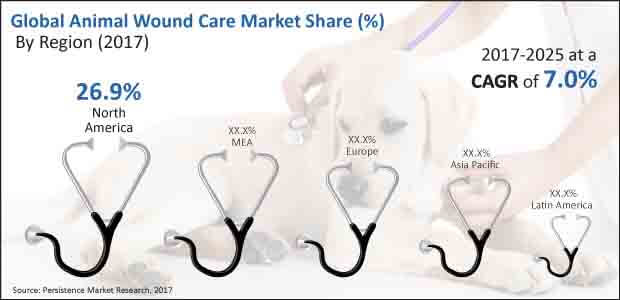Animal Wound Care Market Segmented by Sutures & Stapler and Tissue Adhesives, Traditional Wound Care Products, Sealants and Glue in Surgical Wound Care Products and Foam Dressings, Hydrocolloid Dressings, Film Dressings, Hydrogel Dressings in Advanced Wound Dressings
Industry: Healthcare
Published Date: August-2017
Format: PPT*, PDF, EXCEL
Delivery Timelines: Contact Sales
Number of Pages: 206
Report ID: PMRREP17443
The global animal wound care market is estimated to reach nearly US$ 590 Mn by 2017 end and the market is expected to reach about US$ 1,013 Mn by the end of 2025, reflecting a CAGR of 7.0% over the forecast period (2017–2025). Several factors are responsible for this revenue growth.
The pet veterinary industry was once an offshoot of livestock care. But today these animals are considered more as a part of the family/companion than just “property”. And, as humans treat pets emotionally more like people, they also doing so medically.
Technology first developed for people is now being used on pets. According to an article published by Bloomberg in January 2017, the American Animal Hospital Association (AAHA) stated that more than 80 percent of pet owners think of themselves as their pets’ moms and dads. Americans love their pets so much, they spent US$ 35 Bn on veterinary care in 2015.
According to Bloomberg, Corporations own 15% to 20% of America’s 26,000 pet hospitals. Moreover, consolidators are buying counterparts who work on copying the model pioneered by Veterinary Centers of America (VCA). In 2014 a chain of 250 hospitals of National Veterinary Associates was purchased by Ares Management for US$ 920 Mn. In 2015 the Ontario Teachers’ Pension Plan spent US$ 440 Mn to buy a pet hospital group.
In May 2017, VCA spent US$ 344 Mn for a group of 56 hospitals pooled together by smaller consolidators for the express purpose of flipping them. Since 2015, Mars has bought two hospital groups for undisclosed amounts, adding more than 100 clinics to a portfolio that already includes 950 locations.
Advances in veterinary care over the past few years have come at high price. For instance, costs to treat a torn Anterior Cruciate Ligament (ACL), have soared to US$ 2,000, more than double the US$ 800 people had paid in the past. That doesn't include the costs of diagnostic testing, which can add an additional US$ 500 to a pet owner's bill.
As MRI has become common in many nationwide hospitals, vets use this as a standard care for treating cancer, injuries, etc. The test itself costs US$ 2000 in addition to the prescription cost. While this is an incredibly useful and important diagnostic tool, the cost is out of reach for many pet owners who would struggle to be able to afford the surgery and/or treatment following the MRI, let alone the cost of the test itself.
North America dominated the global animal wound care market in revenue terms in 2016 and is projected to continue to do so throughout the forecast period. North America is expected to be the most attractive market with attractiveness index of 1.3 during the forecast period.
Europe is expected to be the second most lucrative market, with attractiveness index of 1.1 during the forecast period. The Latin America animal wound care market represents a market attractiveness index of 0.5. The MEA animal wound care market is anticipated to record the highest regional CAGR of 7.4%.

Most private veterinarians in earlier times, didn’t have an X-ray machine. Pets getting blood work wasn’t common. But as public attitudes toward pets evolved and medicine science advanced, standards for veterinary care began to change. People’s expectations shifted to a setup of a veterinary medical practice that could provide 21st century medicine. As the number of vets increased, people with means obtained more options than ever for treating their pets’ illnesses.
Many animal shelter facilities have further expanded their operations to become full-service hospitals, providing advanced levels of medical care, products and other services. The increasing spending on vet care and the higher expectation of care from the vets has led to a rise in the standard of care. This is expected to increase the demand for quality animal wound care.
| Attribute | Details |
|---|---|
|
By Product |
|
|
By End User |
|
|
By Region |
|
To know more about delivery timeline for this report Contact Sales
